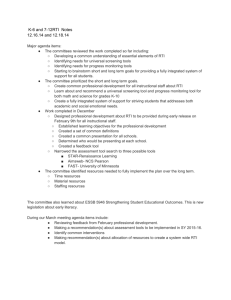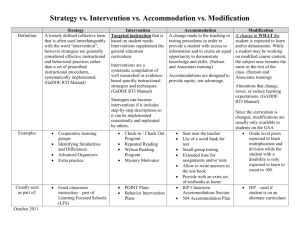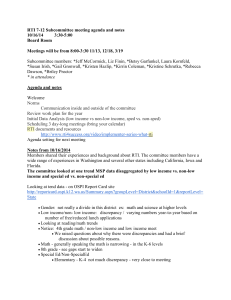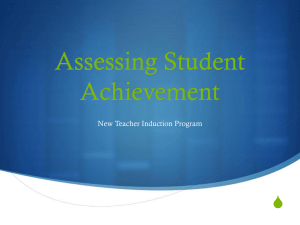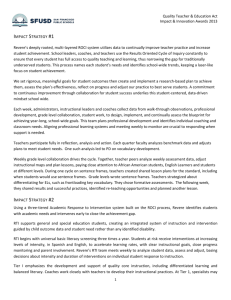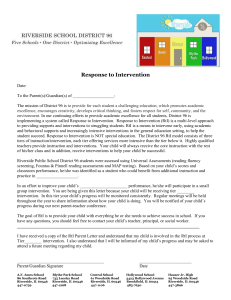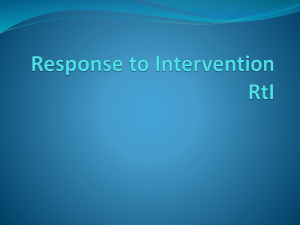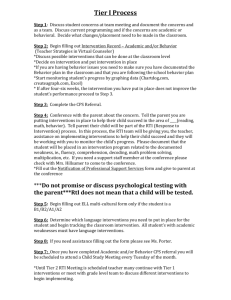RTI Manual, Chapter 1 - Augusta County Public Schools
advertisement
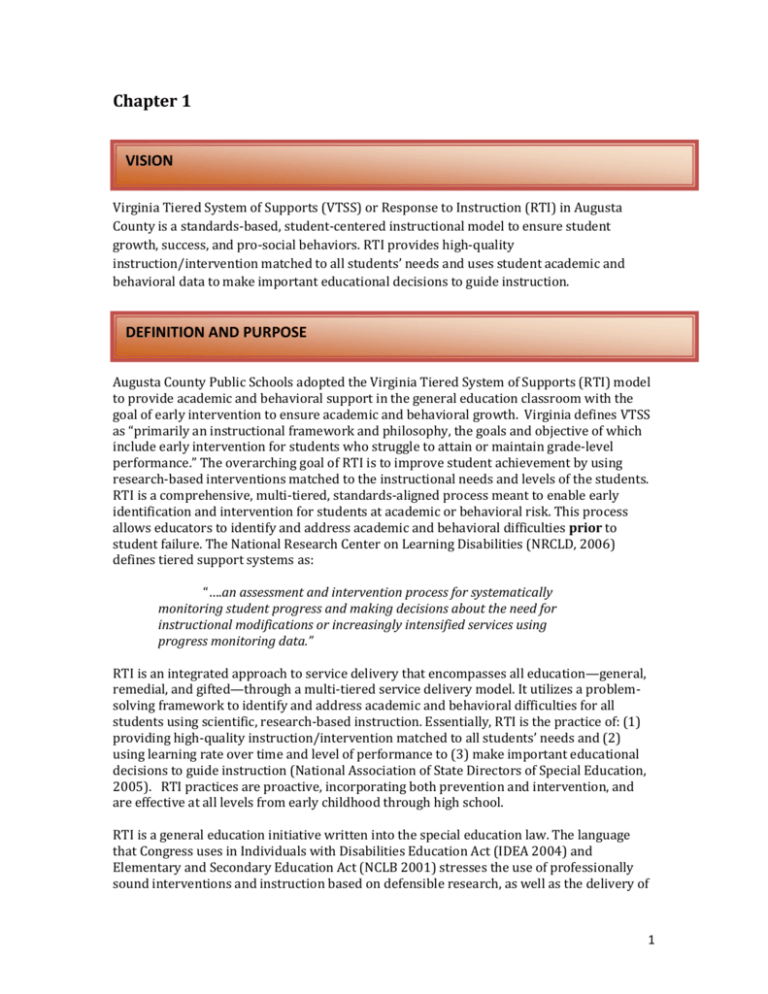
Chapter 1 VISION Virginia Tiered System of Supports (VTSS) or Response to Instruction (RTI) in Augusta County is a standards-based, student-centered instructional model to ensure student growth, success, and pro-social behaviors. RTI provides high-quality instruction/intervention matched to all students’ needs and uses student academic and behavioral data to make important educational decisions to guide instruction. DEFINITION AND PURPOSE Augusta County Public Schools adopted the Virginia Tiered System of Supports (RTI) model to provide academic and behavioral support in the general education classroom with the goal of early intervention to ensure academic and behavioral growth. Virginia defines VTSS as “primarily an instructional framework and philosophy, the goals and objective of which include early intervention for students who struggle to attain or maintain grade-level performance.” The overarching goal of RTI is to improve student achievement by using research-based interventions matched to the instructional needs and levels of the students. RTI is a comprehensive, multi‐tiered, standards-aligned process meant to enable early identification and intervention for students at academic or behavioral risk. This process allows educators to identify and address academic and behavioral difficulties prior to student failure. The National Research Center on Learning Disabilities (NRCLD, 2006) defines tiered support systems as: “….an assessment and intervention process for systematically monitoring student progress and making decisions about the need for instructional modifications or increasingly intensified services using progress monitoring data.” RTI is an integrated approach to service delivery that encompasses all education—general, remedial, and gifted—through a multi-tiered service delivery model. It utilizes a problemsolving framework to identify and address academic and behavioral difficulties for all students using scientific, research-based instruction. Essentially, RTI is the practice of: (1) providing high-quality instruction/intervention matched to all students’ needs and (2) using learning rate over time and level of performance to (3) make important educational decisions to guide instruction (National Association of State Directors of Special Education, 2005). RTI practices are proactive, incorporating both prevention and intervention, and are effective at all levels from early childhood through high school. RTI is a general education initiative written into the special education law. The language that Congress uses in Individuals with Disabilities Education Act (IDEA 2004) and Elementary and Secondary Education Act (NCLB 2001) stresses the use of professionally sound interventions and instruction based on defensible research, as well as the delivery of 1 effective academic and behavior programs to improve student performance. Congress believes that as a result, fewer children will become “instructional casualties.” Recent research shows that the use of multi-tiered models is an effective educational practice within schools to bring high-quality instruction to all students. The key purposes of RTI are: universal screening for all students, data-based decision making, school-wide collaboration, progress monitoring, and evaluating the effectiveness of instruction and interventions. The RTI concepts presented in this document make use of a three-tiered approach that incorporates the aspects of a personalized education. Instruction should be standards-based, student-centered, and rooted in data-driven assessment with the consistent use of best instructional practices and materials that are grounded in research. A holistic approach to problem solving will be used with each child, taking into account cultural, social, and oral language factors. Parents will be considered as partners with the school when making RTI decisions about their children. The purpose of this manual is to provide information, guidance, and resources for schools to implement RTI in Augusta County, RTI will be applied to reading, math, and behavior. CHARACTERISTICS OF ACPS VTSS (RTI) FRAMEWORK ACPS has defined its RTI framework around six major components as described below: • Standards-aligned Instruction: All students receive high‐quality, research‐based instruction in the general education standards‐aligned system. Instruction is differentiated and provided with fidelity in flexible groups. • Universal Screening: All students are screened to determine academic status against grade‐level benchmarks three times a year. • Shared Ownership: All staff (general education teachers, special education teachers, Title I, ELL, intervention specialists, paraprofessionals) assume an active role in students’ assessment and instruction in the standards‐aligned system. • Data-Driven Decision Making: A team of educational professionals analyzes studentperformance data and guides school decisions on instructional changes, choices of interventions, and appropriate rates of progress. Data sources include Universal Screening, Benchmark Assessments, Outcome Assessments, and Progress Monitoring Data. • Tiered Intervention and Service Delivery System: Some students receive increasingly intense levels of targeted, scientifically, research‐based interventions with proven effectiveness dependent upon student need. • Parental Engagement: Parents are an integral part of their children’s education and as such will be an integral part of the RTI process. They will receive detailed information regarding their children’s needs, the type, frequency and delivery of intervention expected, and actual rates of progress, as well as their right to request a special education referral at any time. 2 Essentials All schools (Pre-K—8) will conduct Universal Screening (US) three times a year using division provided assessments. High Schools will screen students using at-risk factors. All (PreK-8) students taking SOL tests and scoring below the 25th percentile or PALS assessment on the most recent universal screening shall be reviewed at Data Day. For students referred for speech/language eligibility, speech and language pathologists will consult with content interventionists regarding establishing goals in academic area(s) of concern. Classroom teachers/interventionists will then provide progressmonitoring data to the eligibility team. Tier 2 and Tier 3 progress monitoring data will be recorded in RTIm Direct. Instructional planning by all teachers will be data-driven. All schools will use a problem-solving model for communication and collaboration. Teachers will utilize high quality, research-based instruction. All schools will provide a designated time for intervention. PreK – 8 schools should designate time each day. Standards-Aligned Instruction The most critical element in the RTI framework is the provision of high-quality, standards‐ aligned instruction to all students using scientific, research-based instruction and intervention delivered with fidelity in all areas of instruction. This means that what students are taught (core curriculum), how students are taught (instructional practices), and how students are assessed are aligned to the SOLs in both content and cognitive levels. This instructional alignment is the first step in implementing a RTI framework. Aligned instruction comprises the following activities: • Teaching topics that are aligned with the standards. • Ensuring an appropriate level of challenge. • Focusing teaching based on the learning needs of each student. • Implementing instructional strategies that 'scaffold', or build, on each other to help students achieve the standards. • Ensuring that the practices and curriculum have demonstrated validity. • Determining and articulating behaviors, conditions, and criteria for success in each lesson. The alignment of standards-based curriculum, effective instructional practices, and aligned assessments form the foundation for RTI that is critical to improve student results. In turn, all staff must have the knowledge and skills necessary to identify the standards being taught, administer aligned assessments, review data to make informed instructional decisions, deliver instruction with the most effective practices, and maintain high 3 expectations. The division is committed to time and resources needed to provide high quality professional development. Universal Screening RTI requires Universal Screening of all students to determine current performance levels, identify learning needs, and to proactively identify those students at risk for academic or behavioral difficulties. All students, including special education students, are screened in reading and math a minimum of three times per year using screening instruments that are administered with fidelity. Students not at benchmark for a RTI skill, or those who are in danger of not attaining the next benchmark, should be provided further diagnostic assessment and intervention. Results are analyzed by classroom teachers and the designated grade-level data team and are used to determine appropriate instructional groupings and to design appropriate intervention. Screening tools provide an indication in identifying students’ needs. They should be research‐based, brief, and easily administered. Screening must be highly correlated to skills assessed and should have benchmarks that are predictive of future performance Augusta County Public Schools has chosen to use division defined assessments in reading and mathematics that allow students to be compared to national and local norms. Student performance will be evaluated against these norms to determine instructional need. Screening measures must be administered efficiently, consistently, and with fidelity. It is imperative that, for screening to have true meaning all staff administering and interpreting screening assessments be thoroughly trained and retrained as needed. Schools may opt to solely utilize their own staff or may call on other support personnel to administer universal screening measures if such personnel are available. These must be well planned as even the most subtle issue may undermine the efficiency and efficacy of the system. Screening results are of little value unless a mechanism is in place to allow classroom teachers to analyze screening results in a timely fashion. For PreK – 8 students, refer to the division’s assessment calendar for a timeline. For high school students, screening results are reviewed after each formal and informal reporting period. Teams should generate grade or classroom-wide implications for addressing instructional (core) deficits before identifying individual students for further assessment. Teams should also keep in mind that the screening data is only one data point and that multiple data points should be used in identifying students in need of interventions. Once students are identified, further diagnostic assessment to identify skill deficits will be necessary before interventions can begin. 4 Shared Ownership The RTI framework, by design, promotes shared ownership of student learning across staff and programs. All staff (general ed., special ed., Title 1, ELL, intervention specialists, paraprofessionals, principals, etc.) assumes an active role in each level of tiered instruction in the Virginia Tiered System of Supports model. All staff share all students. • • • • General educators provide Tier 1 core instruction in the general education classroom, and may have an active role in Tier 1 and Tier 2 interventions and monitoring activities. Although specialists, interventionists, and paraprofessionals may be utilized to assist core instruction when available, the responsibility of the core instruction belongs to the general educators. Sufficient Tier 1 core instruction is provided by the differentiation of core instruction and the use of smaller, flexible groups within the core. All staff can be used to help scaffold and differentiate instruction and to ensure that additional opportunities to learn are available to students through the tiered service delivery system. Paraprofessionals provide key support to students with reinforced learning, instructional practice, and fluency tasks. Common planning time to enable collaborative practices is necessary at all grade levels. Teachers and specialists must operate with the belief of “we are all responsible for the instruction and learning of all students”. Title I and special educators may provide instruction and participate in progressmonitoring activities at all levels of tiered instruction. Title I Targeted Assistance Model will focus on Tier 3 students and monitor student progress. Specialists (art, music, P.E., media) may also participate in various ways with RTI implementation at all levels. The principal’s role is critical in developing shared ownership and in ensuring all role changes are strategically planned and supported with appropriate training and coaching. The allocation of instructional resources is vital to RTI implementation and will require shifts in time allocation, scheduling, and staffing patterns. Guiding principles include: • • • • • School resources and staff expertise are allocated based on student need. Expert teachers and specialists are assigned to the neediest students. Adjustments to the infrastructure are made to provide flexible schedules, grouping options, time for teacher collaboration around student learning (data analysis teaming), and flexible staff assignments. The RTI framework requires competency and fidelity of implementation, which demands staff development. Training and support are critical as staff assumes nontraditional roles in the RTI process. General education teachers are all responsible for coordinating all the intervention for their student. Interventions provided for individual students must be reinforced in core. RTI may require the realignment of existing resources, not always the acquisition of additional resources. 5 Data-Based Decision Making Data‐based decision-making drives the RTI framework. Staff members use data to monitor student achievement and set achievement goals. ACPS assessment data are used to set student goals to improve achievement. Student performance is monitored on an established, ongoing basis to determine the program and instructional adjustments needed to ensure student success. Data-based decision making determines the appropriate instructional grouping, curriculum, tiered interventions, instructional strategies, and the assessment procedures needed to improve student achievement. Data-based decision making is done through an efficient process of gathering data and developing processes to analyze the data and adjust instruction. Teachers must be trained in both these processes and in understanding the instructional implications of each data source. RTI Data Teaming: Grade-Level Teaming (PreK – 8): Grade‐level teams meet periodically (at least once per month) to review screening data, set grade‐level goals, plan instruction, make instructional adjustments, and monitor student progress. Students at risk for academic failure as well as those in need of extension are identified and instructional plans are developed to meet the needs of those students. These teams also adjust core instruction across the grade as necessary. Data Day Teaming (PreK-8): The Data Day team is responsible for the monitoring of tiered interventions based on progress monitoring data. Teams of teachers and other school and division staff as appropriate meet monthly to monitor student progress, the fidelity of intervention implementation, and the impact of instruction on student learning. Departmental teaming (HS): Departmental teams meet periodically (at least once per grading period) to review screening data, set department‐level goals, plan instruction, make instructional adjustments, and monitor student progress. Students at risk for academic failure as well as those in need of extension are identified and instructional plans are developed to meet the needs of those students. These teams also adjust core instruction across the grade as necessary. Tiered Intervention & Service Delivery System The RTI approach incorporates a multi-tiered model of service delivery in which each tier represents an increasingly intense level of services associated with increasing levels of learner needs. ACPS has adopted a three-tiered framework that provides standards‐aligned instruction and intervention support to all students. The framework is implemented within the general education program and cannot be used to deny parents the right to an evaluation for special education services. In a RTI system, all students receive instruction in 6 the core curriculum (Tier 1), which may be supplemented by strategic (Tier 2), and/or intensive (Tier 3) interventions for individual students as needed. Therefore, all students, including those with high-incidence disabilities, may be found in Tier 1 (with the exception of students who have low incidence disabilities who are provided services in a selfcontained environment). Important features, such as universal screening, progress monitoring, fidelity of implementation and problem solving occur within each tier. A complete description of the three-tiered model is discussed in Chapter 2 of this manual. Parental Engagement Parental and family engagement is an important factor in improving student achievement, and it is a key aspect of a successful RTI program. ACPS recognizes the critical role of parents in the RTI process. Schools should develop specific strategies/activities to engage parents in all phases of RTI. The school should provide written information to all parents regarding the RTI process. This can be addressed in a parental letter, at PTA meetings, and in the school newsletter. Parents should be provided an overview of the RTI framework, tiered instruction, types of programs used, and tips to support their children at home and at school. The overview should include timelines, explanation of interventions, and possible outcomes. Also, student data collected during RTI implementation should be shared with parents on a routine basis. Parents provide a critical perspective on students, thus increasing the likelihood that RTI interventions will be effective. For this reason, schools must make a concerted effort to involve parents as early as possible, beginning with instruction in the core curriculum. This can be done through traditional methods such as parent-teacher conferences, regularly scheduled meetings, or by other methods. Specifically, parents will be invited to participate in problem-solving meetings to consider Tier 3 placement. They must receive ongoing and precise information regarding their child’s interventions and progress. This information should include but not be limited to: • • • • • • Their child’s needs, A description of the specific intervention and who is delivering instruction, Clearly stated intervention goals and academic progress expected for their child, Regular progress or lack of progress reports, Specific information about RTI, and The right to request a special education evaluation at any time Parent conferences at schools implementing RTI are data driven and are designed to keep parents abreast of their child’s progress. Student data from universal screening and progress monitoring will be included with all parent/teacher conferences. RTI is a method of delivering the general education curriculum for all students so written consent is not required before administering universal screenings, curriculum based measures (CBM), and targeted assessments when these tools are used to determine 7 instructional needs. However, when a student fails to respond to interventions and the decision is made to evaluate a student for special education eligibility, written consent must be obtained in accordance with ACPS special education policy and procedures. Notification of universal screening is included in the student handbook and the annual assessment calendar is posted on the division website. 8
